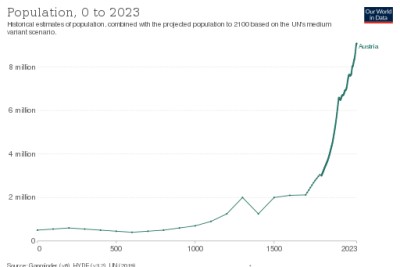Austria's Population will Exceed Nine Million this Year
Austria's population is nearing nine million and should reach this mark sometime in 2022. Read more about Austria's recent population increase.
 Austria's population is expected to reach nine million over the course of 2022. / Picture: © Wikimedia Commons / Max Roser, CC BY-SA 3.0 (https://creativecommons.org/licenses/by-sa/3.0)
Austria's population is expected to reach nine million over the course of 2022. / Picture: © Wikimedia Commons / Max Roser, CC BY-SA 3.0 (https://creativecommons.org/licenses/by-sa/3.0)
According to a recent study, Austria’s population was 8,979,894 at the beginning of 2022 and should reach nine million sometime this year.
The population at the start of the year was 47,230 (+0.53%) more than at the beginning of 2021.
Additionally, Austria recorded a slightly stronger population increase in 2021 than in the year before (2020: +31,600 people or +0.36%).
The last time there was a marginally larger increase in the number of inhabitants was in 2018 (+49,402 people or +0.56%).
"Austria continues to grow. After the population increased by 0.53% to 8.98 million in 2021, it is expected to reach the nine million mark in the course of 2022. The population growth is solely attributable to people with non-Austrian citizenship. Without them, Austria would not have grown in 2021, but would have shrunk," explained Statistics Austria Director General Tobias Thomas.
Upper Austria had the highest growth and Salzburg the lowest
With an increase of 0.65%, Upper Austria recorded the largest percentage increase of all Austrian provinces in 2021.
The increases in Vorarlberg (+0.59%) , Vienna (+0.57%) , Tyrol (+0.55%) and Burgenland (+0.54%) were also above the national average.
Lower Austria and Styria (both +0.48%) and Carinthia (+0.44%) ranked slightly below the Austria-wide population growth.
Salzburg had the lowest increase in the number of inhabitants at only +0.36%.
Population growth in 77 political districts, decline in 17 districts
At the regional level, there was population growth in a total of 77 political districts in 2021.
The largest increases were in Eisenstadt, the capital of Burgenland (+2.31%), the district of Graz-Umgebung (+1.63%) and the two statutory cities of Wiener Neustadt (+1.49%) and Villach (+1.36%).
However, the political districts of Braunau, Bruck an der Leitha, Vöcklabruck, Leibnitz, Urfahr-Umgebung and Imst also recorded population growth of more than one percent.
On the other hand, the population figures declined in 17 political districts. The population shrank the most in the small town of Rust (-0.75%) and in the districts of Murau (-0.72%) and Gmünd (-0.50%).
In addition, the number of inhabitants decreased in the cities of Innsbruck, Salzburg, Steyr and Waidhofen an der Ybbs, and the remaining three districts of Waldviertel (Horn, Waidhofen an der Thaya and Zwettl), as well as in Lilienfeld, Güssing, the two Styrian districts of Südoststeiermark and Murtal, and the three Carinthian districts of Wolfsberg, Spittal an der Drau and Hermagor.
Within Vienna, 14 districts recorded a population decline, while nine districts saw an increase.
Liesing (+3.03%), Donaustadt (+2.53%) and Floridsdorf (+2.45%) grew the most.
At the same time, the largest population losses were in Margareten (-1.18%), Mariahilf (-1.17%) and Neubau (-1.09%).
17.7% of the population are foreign nationals
According to the preliminary results, a total of 1,587,251 people with foreign citizenship lived in Austria on January 1, 2022.
The proportion of foreign nationals in the total population rose from 17.1% at the beginning of 2021 to 17.7% at the start of 2022.
In the course of 2021, the number of foreign nationals increased by 56,179 (+3.67 %), while the number of Austrian nationals decreased (-8,949 people or -0.12%).



